Design and Analysis of Modified U-Shaped Four Element MIMO Antenna for Dual-Band 5G Millimeter Wave Applications
Abstract
:1. Introduction
2. Antenna Design and Analysis
2.1. Single Element Design and Evolution
2.2. Effect of Feed Width on Impedance Performance
2.3. Effect of Ground Slot on Impedance Performance
2.4. Effect of Slots on Isolation Performance
3. Results and Discussions
3.1. S-Parameters
3.2. Radiation Performance
3.3. MIMO Performance
4. Conclusions
Author Contributions
Funding
Data Availability Statement
Acknowledgments
Conflicts of Interest
References
- Cisco Systems, Mobile Visual Networking Index (VNI) Forecast Project 7-Fold Increase in Global Mobile Data Traffic from 2016–2021. Available online: https://newsroom.cisco.com/press-release-content?articleId=1819296 (accessed on 10 July 2023).
- FCC Takes Steps to Make Millimeter Wave Spectrum Available for 5G; Federal Communications Commission: Washington, DC, USA, 2019.
- Rappaport, T.S.; Xing, Y.; MacCartney, G.R.; Molisch, A.F.; Mellios, E.; Zhang, J. Overview of millimeter wave communications for fifth-generation (5G) wireless networks—With a focus on propagation models. IEEE Trans. Antennas Propag. 2017, 65, 6213–6230. [Google Scholar] [CrossRef]
- Niu, Y.; Li, Y.; Jin, D.; Su, L.; Vasilakos, A.V. A survey of millimeter wave communications (mmWave) for 5G: Opportunities and challenges. Wirel. Netw. 2015, 21, 2657–2676. [Google Scholar] [CrossRef]
- Busari, S.A.; Mumtaz, S.; Al-Rubaye, S.; Rodriguez, J. 5G millimeter-wave mobile broadband: Performance and challenges. IEEE Commun. Mag. 2018, 56, 137–143. [Google Scholar] [CrossRef]
- Foschini, G.J.; Gans, M.J. On limits of wireless communications in a fading environment when using multiple antennas. Wirel. Pers. Commun. 1998, 6, 311–336. [Google Scholar] [CrossRef]
- Ali, A.; Munir, M.E.; Marey, M.; Mostafa, H.; Zakaria, Z.; Al-Gburi, A.J.A.; Bhatti, F.A. A Compact MIMO Multiband Antenna for 5G/WLAN/WIFI-6 Devices. Micromachines 2023, 14, 1153. [Google Scholar] [CrossRef]
- Saeidi, T.; Al-Gburi, A.J.A.; Karamzadeh, S. A Miniaturized Full-Ground Dual-Band MIMO Spiral Button Wearable Antenna for 5G and Sub-6 GHz Communications. Sensors 2023, 23, 1997. [Google Scholar] [CrossRef]
- Yang, B.; Yu, Z.; Lan, J.; Zhang, R.; Zhou, J.; Hong, W. Digital beamforming-based massive MIMO transceiver for 5G millimeter-wave communications. IEEE Trans. Microw. Theory Tech. 2018, 66, 3403–3418. [Google Scholar] [CrossRef]
- Hussain, N.; Awan, W.A.; Ali, W.; Naqvi, S.I.; Zaidi, A.; Le, T.T. Compact wideband patch antenna and its MIMO configuration for 28 GHz applications. AEU Int. J. Electron. Commun. 2021, 132, 153612. [Google Scholar] [CrossRef]
- Ali, W.; Das, S.; Medkour, H.; Lakrit, S. Planar dual-band 27/39 GHz millimeter-wave MIMO antenna for 5G applications. Microsyst. Technol. 2021, 27, 283–292. [Google Scholar] [CrossRef]
- Yang, R.; Xi, S.; Cai, Q.; Chen, Z.; Wang, X.; Liu, G. A Compact Planar Dual-Band Multiple-Input and Multiple-Output Antenna with High Isolation for 5G and 4G Applications. Micromachines 2021, 12, 544. [Google Scholar] [CrossRef]
- Jetti, C.R.; Nandanavanam, V.R. Trident-shape strip loaded dual band-notched UWB MIMO antenna for portable device applications. AEU Int. J. Electron. Commun. 2018, 83, 11–21. [Google Scholar] [CrossRef]
- Jetti, C.; Nandanavanam, V. A very compact MIMO antenna with triple band-notch function for portable UWB systems. Prog. Electromagn. Res. C 2018, 82, 13–27. [Google Scholar] [CrossRef] [Green Version]
- Sabek, A.R.; Ali, W.A.; Ibrahim, A.A. Minimally coupled two-element MIMO antenna with dual band (28/38 GHz) for 5G wireless communications. J. Infrared Millim. Terahertz Waves 2022, 43, 335–348. [Google Scholar] [CrossRef]
- Yang, B.; Yu, Z.; Dong, Y.; Zhou, J.; Hong, W. Compact tapered slot antenna array for 5G millimeter-wave massive MIMO systems. IEEE Trans. Antennas Propag. 2017, 65, 6721–6727. [Google Scholar] [CrossRef]
- Arabi, O.; See, C.H.; Ullah, A.; Ali, N.; Liu, B.; Abd-Alhameed, R.; McEwan, N.J.; Excell, P.S. Compact Wideband MIMO diversity antenna for mobile applications using multi-layered structure. Electronics 2020, 9, 1307. [Google Scholar] [CrossRef]
- Ali, W.A.; Ibrahim, A.A.; Ahmed, A.E. Dual-Band Millimeter Wave 2 × 2 MIMO Slot Antenna with Low Mutual Coupling for 5G Networks. Wirel. Pers. Commun. 2023, 129, 2959–2976. [Google Scholar] [CrossRef]
- Farahat, A.E.; Hussein, K.F. Dual-band (28/38 GHz) wideband MIMO antenna for 5G mobile applications. IEEE Access 2022, 10, 32213–32223. [Google Scholar] [CrossRef]
- Tu, D.T.T.; Phuong, N.T.B.; Son, P.D.; Van Yem, V. Improving Characteristics of 28/38GHz MIMO Antenna for 5G Applications by Using Double-Side EBG Structure. J. Commun. 2019, 14, 1–8. [Google Scholar] [CrossRef]
- Abbas, E.A.; Ikram, M.; Mobashsher, A.T.; Abbosh, A. MIMO Antenna System for Multi-band Millimeter-wave 5G and Wideband 4G Mobile Communications. IEEE Access. 2019, 7, 181916–181923. [Google Scholar] [CrossRef]
- Ikram, M.; Nguyen-Trong, N.; Abbosh, A. Multiband MIMO microwave and millimeter antenna system employing dual-function tapered slot structure. IEEE Trans. Antennas Propag. 2019, 67, 5705–5710. [Google Scholar] [CrossRef]
- Tu, D.T.T.; Thang, N.G.; Ngoc, N.T.; Phuong, N.T.B.; Van Yem, V. 28/38 GHz dual-band MIMO antenna with low mutual coupling using novel round patch EBG cell for 5G applications. In Proceedings of the 2017 International Conference on Advanced Technologies for Communications (ATC), Quy Nhon, Vietnam, 18–20 October 2017; IEEE: Piscataway, NJ, USA, 2017; pp. 64–69. [Google Scholar]
- Jilani, S.F.; Alomainy, A. Millimetre-wave T-shaped MIMO antenna with defected ground structures for 5G cellular networks. IET Microw. Antennas Propag. 2018, 12, 672–677. [Google Scholar] [CrossRef]
- Aghoutane, B.; Das, S.; Ghzaoui, M.E.; Madhav, B.T.P.; El Faylali, H. A novel dual band high gain 4-port millimeter wave MIMO antenna array for 28/37 GHz 5G applications. AEU Int. J. Electron. Commun. 2022, 145, 154071. [Google Scholar] [CrossRef]
- Khalid, M.; Iffat Naqvi, S.; Hussain, N.; Rahman, M.; Mirjavadi, S.S.; Khan, M.J.; Amin, Y. 4-Port MIMO antenna with defected ground structure for 5G millimeter wave applications. Electronics 2020, 9, 71. [Google Scholar] [CrossRef] [Green Version]
- Bilal, M.; Naqvi, S.I.; Hussain, N.; Amin, Y.; Kim, N. High-Isolation MIMO antenna for 5G millimeter-wave communication systems. Electronics 2022, 11, 962. [Google Scholar] [CrossRef]
- Hussain, M.; Mousa Ali, E.; Jarchavi, S.M.R.; Zaidi, A.; Najam, A.I.; Alotaibi, A.A.; Althobaiti, A.; Ghoneim, S.S. Design and characterization of compact broadband antenna and its MIMO configuration for 28 GHz 5G applications. Electronics 2022, 11, 523. [Google Scholar] [CrossRef]
- Hussain, M.; Awan, W.A.; Ali, E.M.; Alzaidi, M.S.; Alsharef, M.; Elkamchouchi, D.H.; Alzahrani, A.; Fathy Abo Sree, M. Isolation Improvement of Parasitic Element-Loaded Dual-Band MIMO Antenna for Mm-Wave Applications. Micromachines 2022, 13, 1918. [Google Scholar] [CrossRef]
- Sghaier, N.; Belkadi, A.; Hassine, I.B.; Latrach, L.; Gharsallah, A. Millimeter-Wave Dual-Band MIMO Antennas for 5G Wireless Applications. J. Infrared Millim. Terahertz Waves 2023, 44, 297–312. [Google Scholar] [CrossRef]
- Roshani, S.; Shahveisi, H. Mutual coupling reduction in microstrip patch antenna arrays using simple microstrip resonator. Wireless Pers. Commun. 2022, 126, 1665–1677. [Google Scholar] [CrossRef]
- Sun, L.; Feng, H.; Li, Y.; Zhang, Z. Compact 5G MIMO mobile phone antennas with tightly arranged orthogonal-mode pairs. IEEE Trans. Antennas Propag. 2018, 66, 6364–6369. [Google Scholar] [CrossRef]
- Raheel, K.; Altaf, A.; Waheed, A.; Kiani, S.H.; Sehrai, D.A.; Tubbal, F.; Raad, R. E-Shaped H-Slotted Dual Band mmWave Antenna for 5G Technology. Electronics 2021, 10, 1019. [Google Scholar] [CrossRef]
- Blanch, S.; Romeu, J.; Corbella, I. Exact representation of antenna system diversity performance from input parameter description. Electron. Lett. 2003, 39, 705–707. [Google Scholar] [CrossRef] [Green Version]
- Addepalli, T.; Babu Kamili, J.; Kumar Bandi, K.; Nella, A.; Sharma, M. Lotus flower-shaped 4/8-element MIMO antenna for 5G n77 and n78 band applications. J. Electromagn. Waves Appl. 2022, 36, 1404–1422. [Google Scholar] [CrossRef]
- Addepalli, T.; Kumar, M.S.; Jetti, C.R.; Gollamudi, N.K.; Kumar, B.K.; Kulkarni, J. Fractal Loaded, Novel, and Compact Two-and Eight-Element High Diversity MIMO Antenna for 5G Sub-6 GHz (N77/N78 and N79) and WLAN Applications, Verified with TCM Analysis. Electronics 2023, 12, 952. [Google Scholar] [CrossRef]
- Addepalli, T.; Vidyavathi, T.; Neelima, K.; Sharma, M.; Kumar, D. Asymmetrical fed Calendula flower-shaped four-port 5G-NR band (n77, n78, and n79) MIMO antenna with high diversity performance. Int. J. Microw. Wirel. Technol. 2022, 1–15. [Google Scholar] [CrossRef]
- Fritz-Andrade, E.; Jardon-Aguilar, H.; Tirado-Mendez, J.A. The correct application of total active reflection coefficient to evaluate MIMO antenna systems and its generalization to N ports. Int. J. RF Microw. Comput. Aided Eng. 2020, 30, e22113. [Google Scholar] [CrossRef]
- Glazunov, A.A.; Molisch, A.F.; Tufvesson, F. Mean effective gain of antennas in a wireless channel. IET Microw. Antennas Propag. 2009, 3, 214–227. [Google Scholar] [CrossRef] [Green Version]
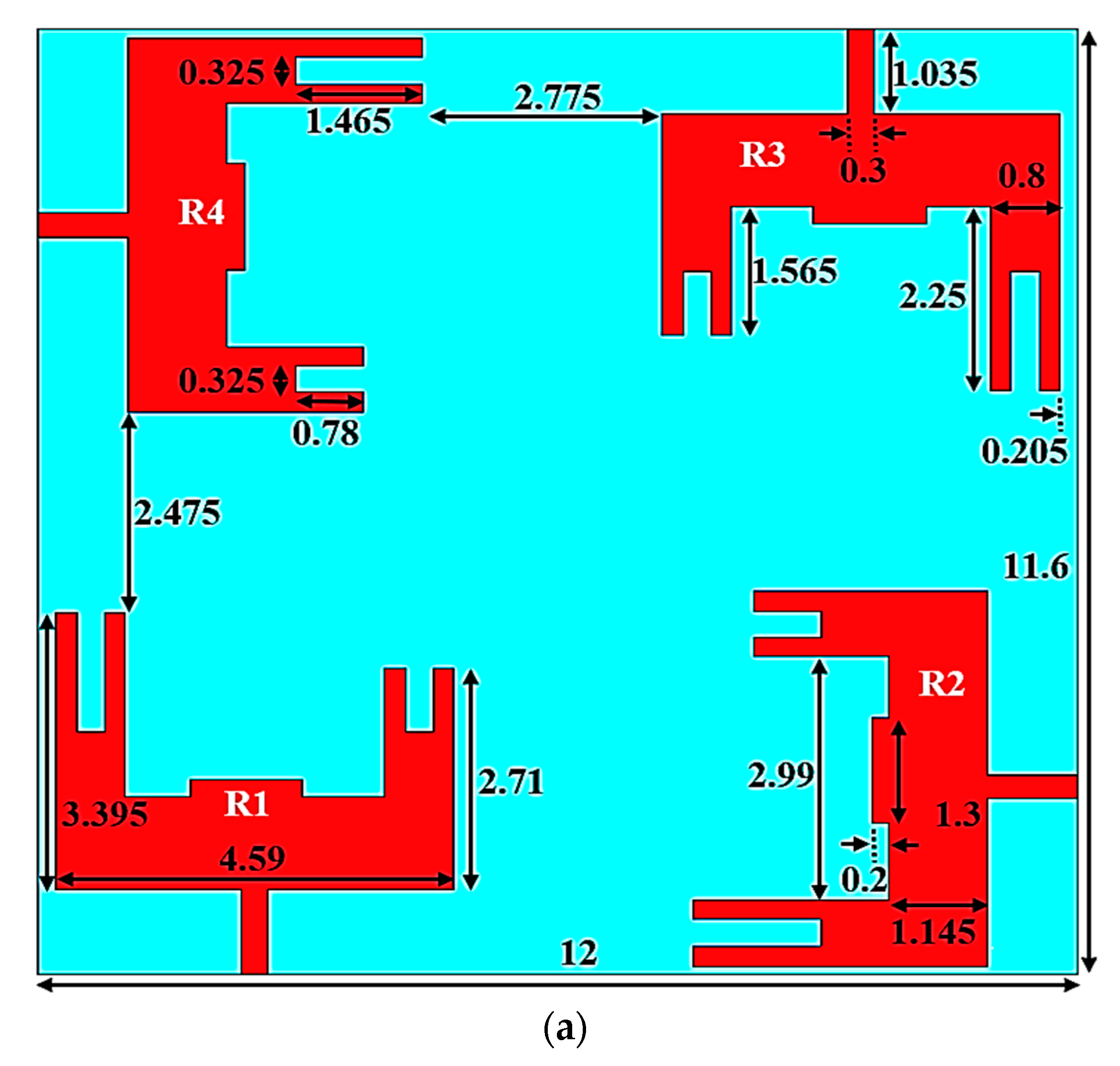
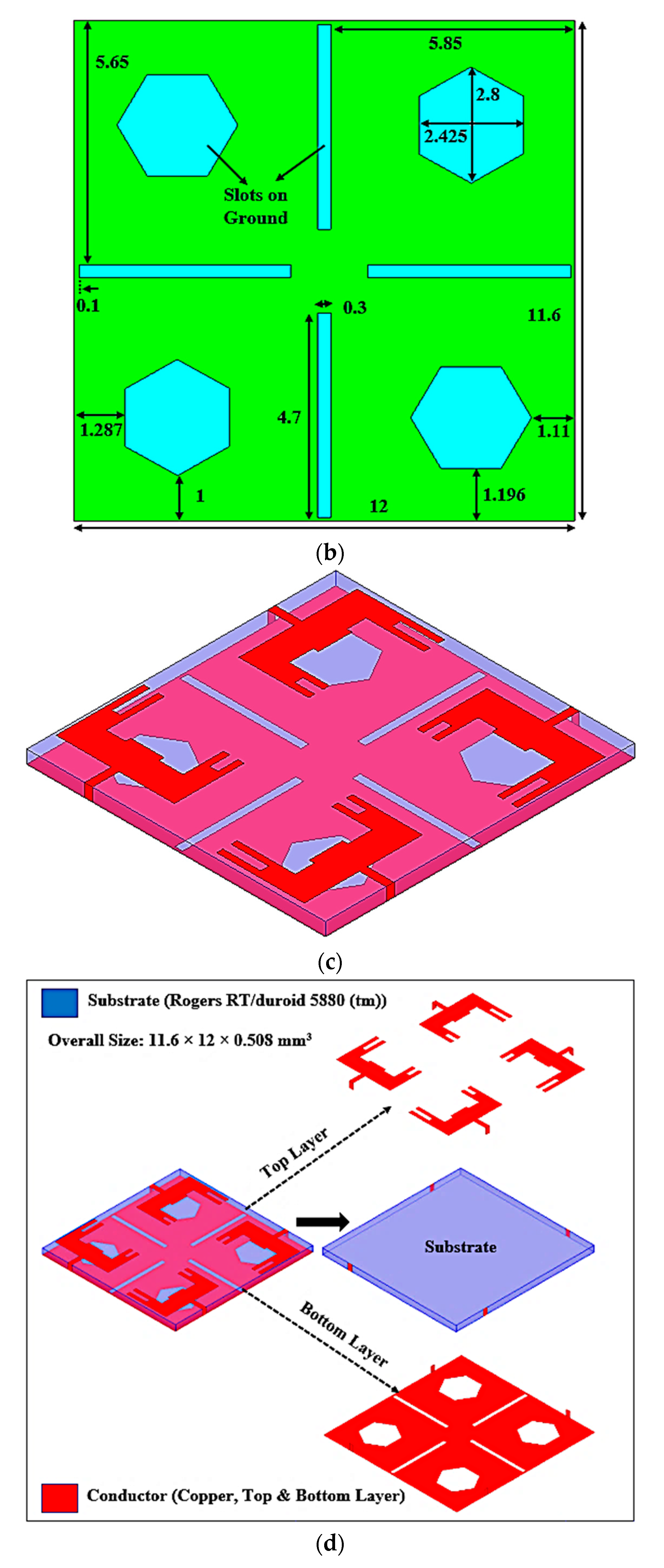
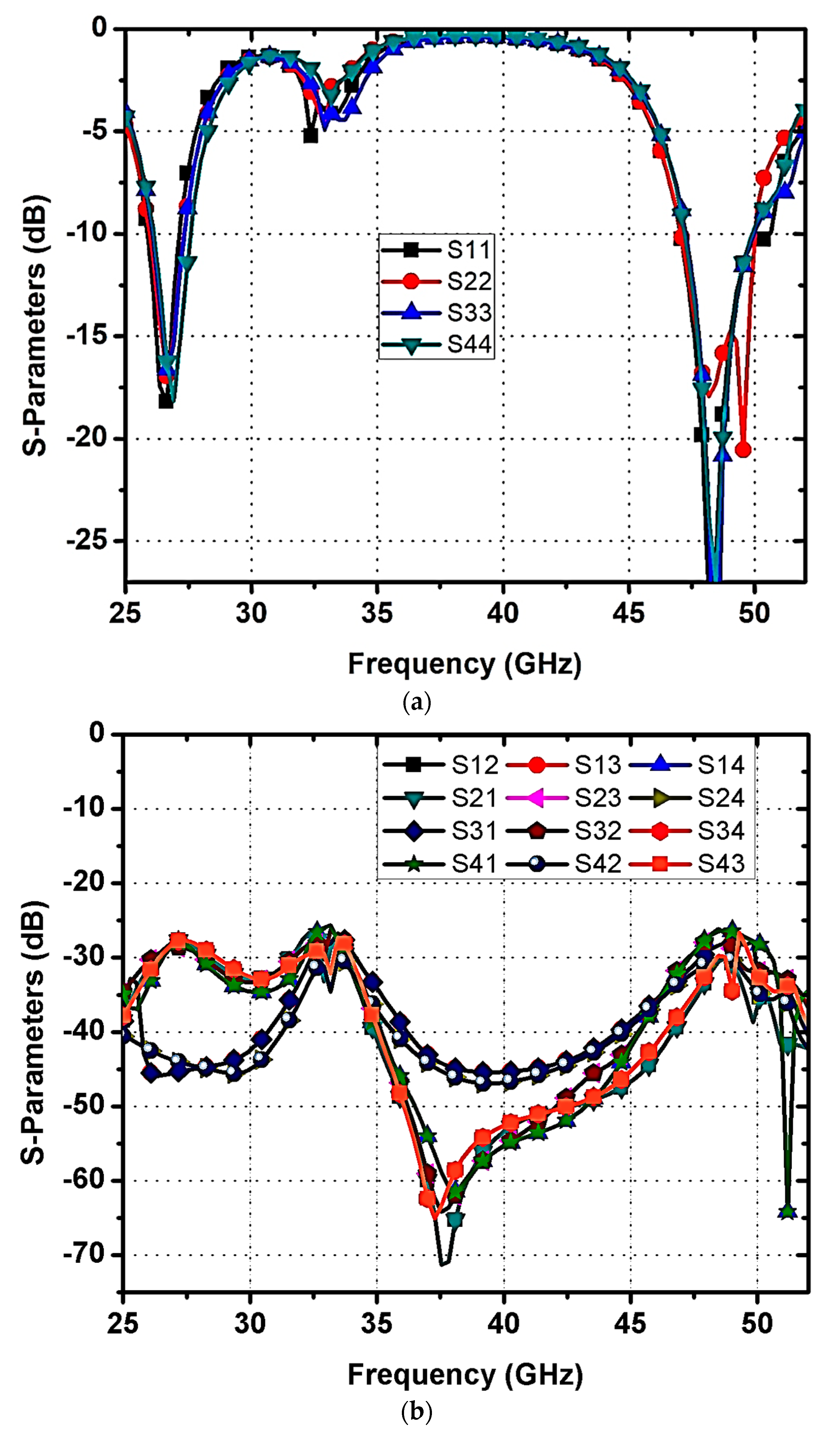

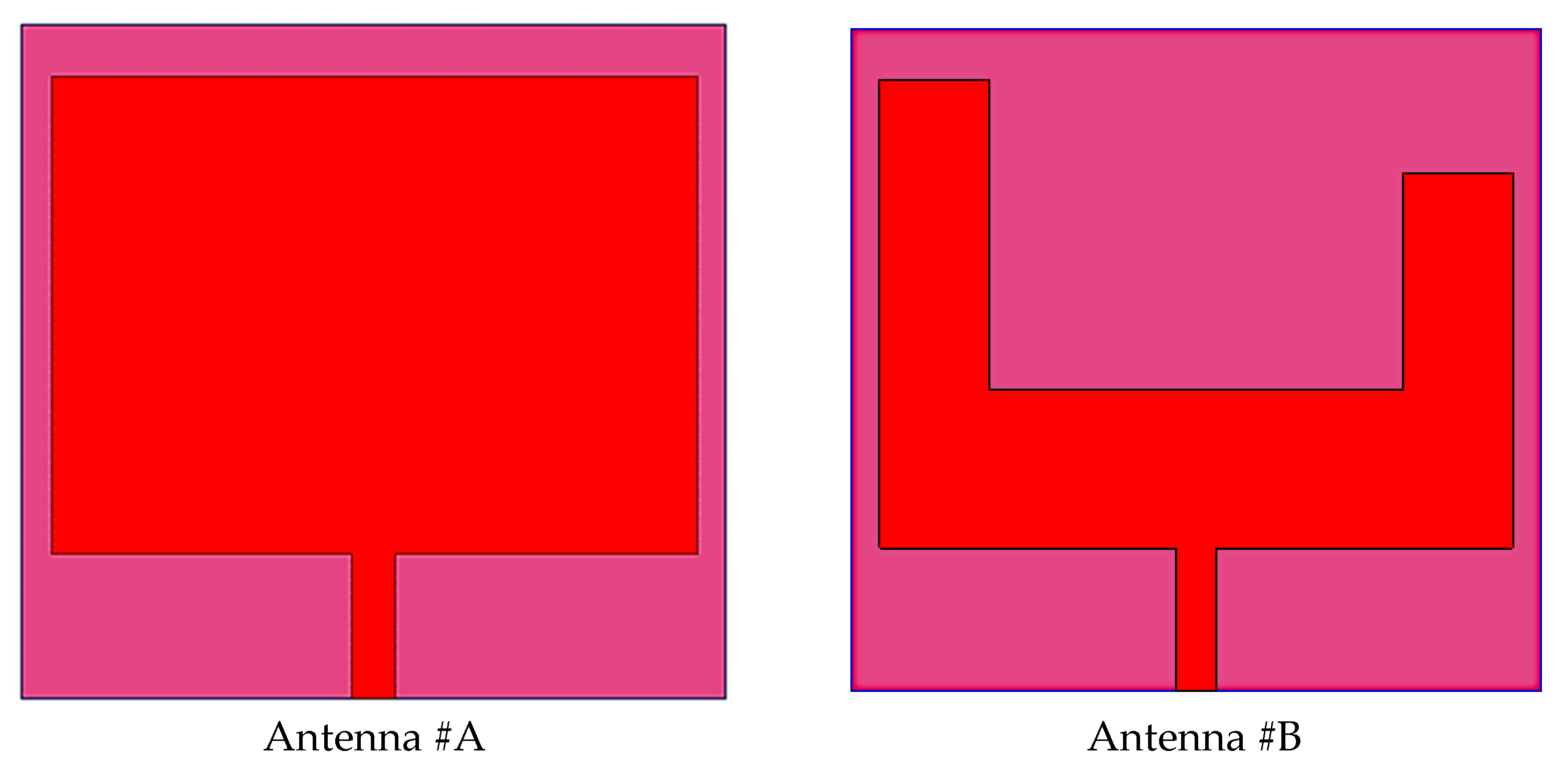
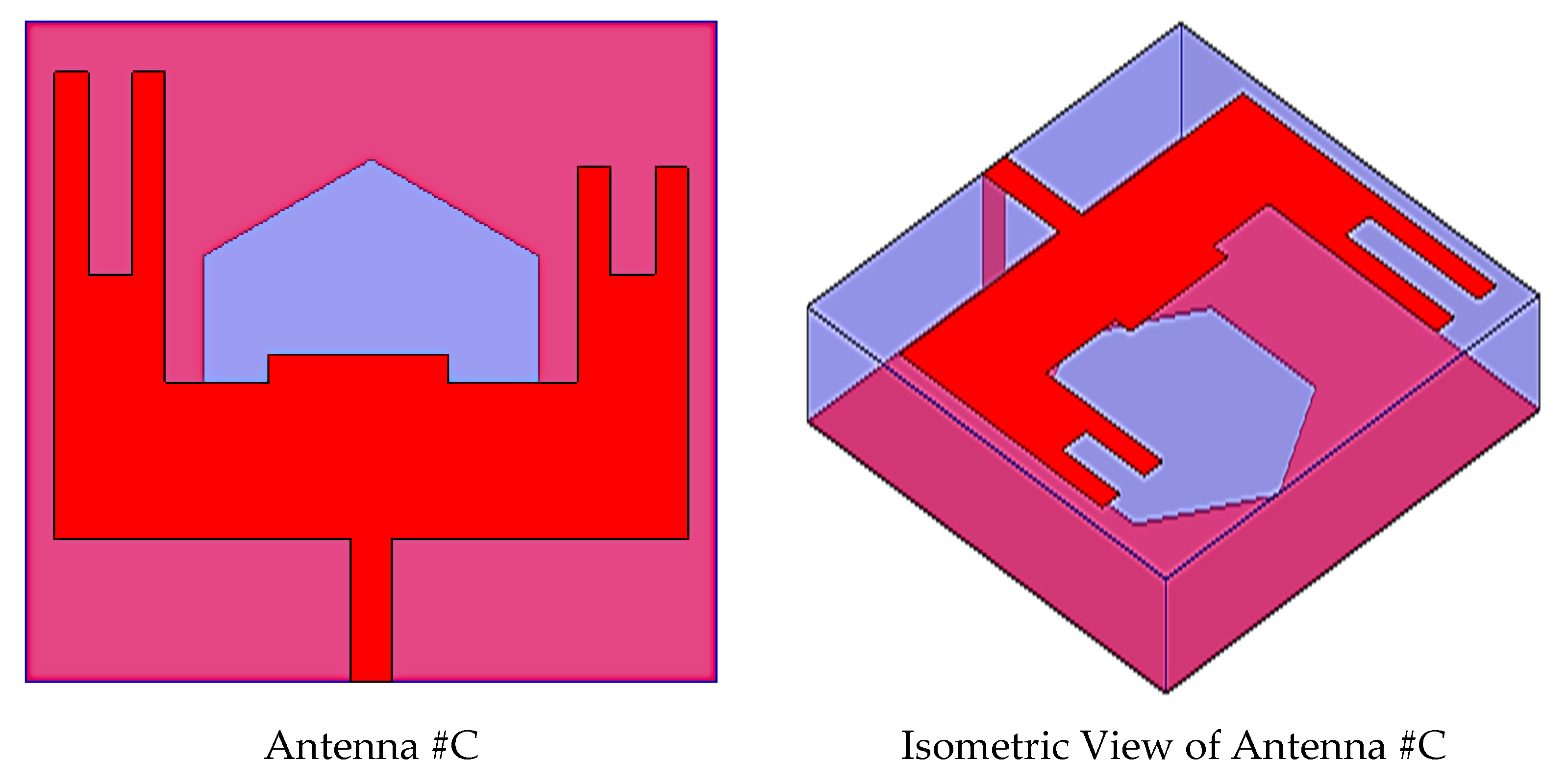



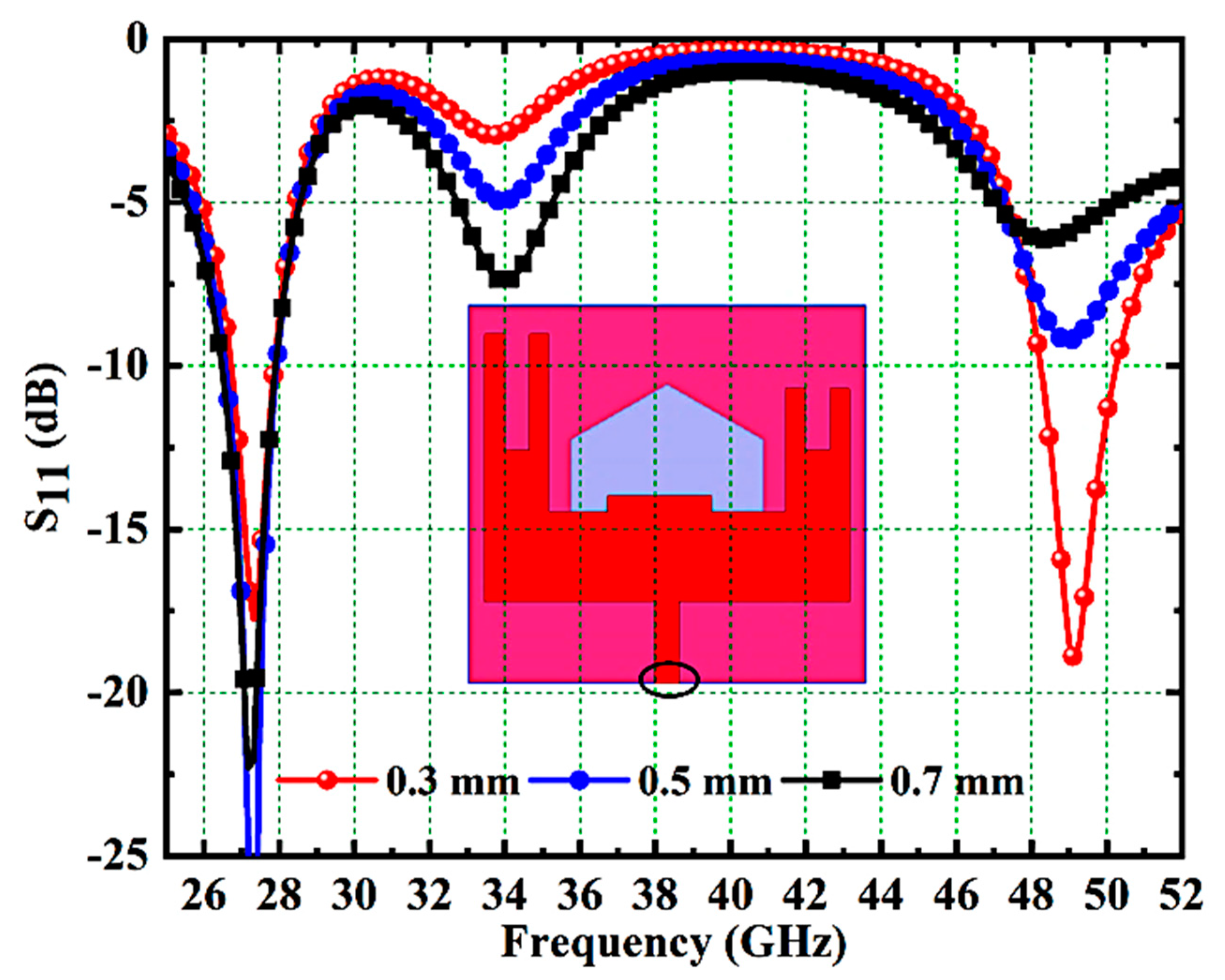
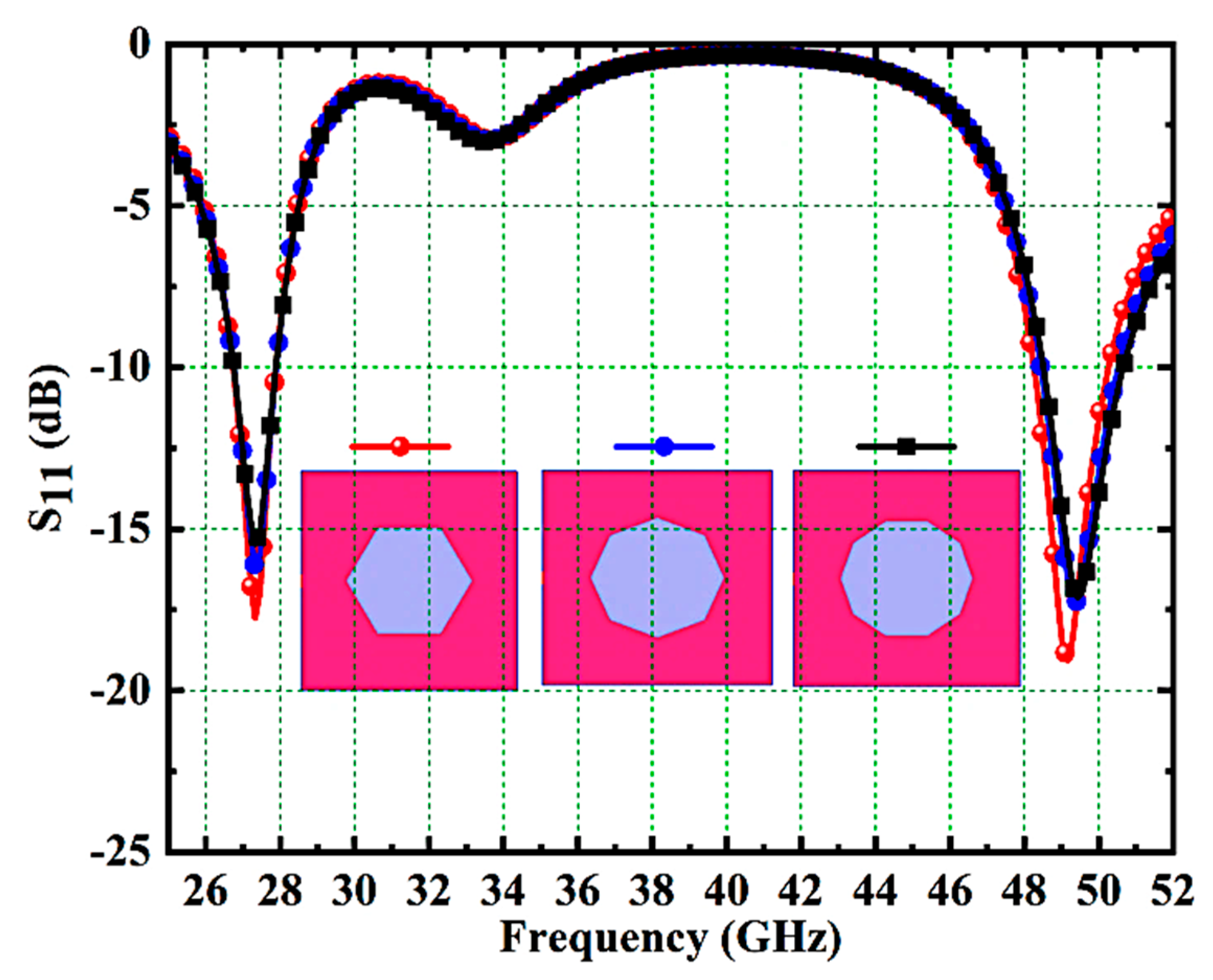
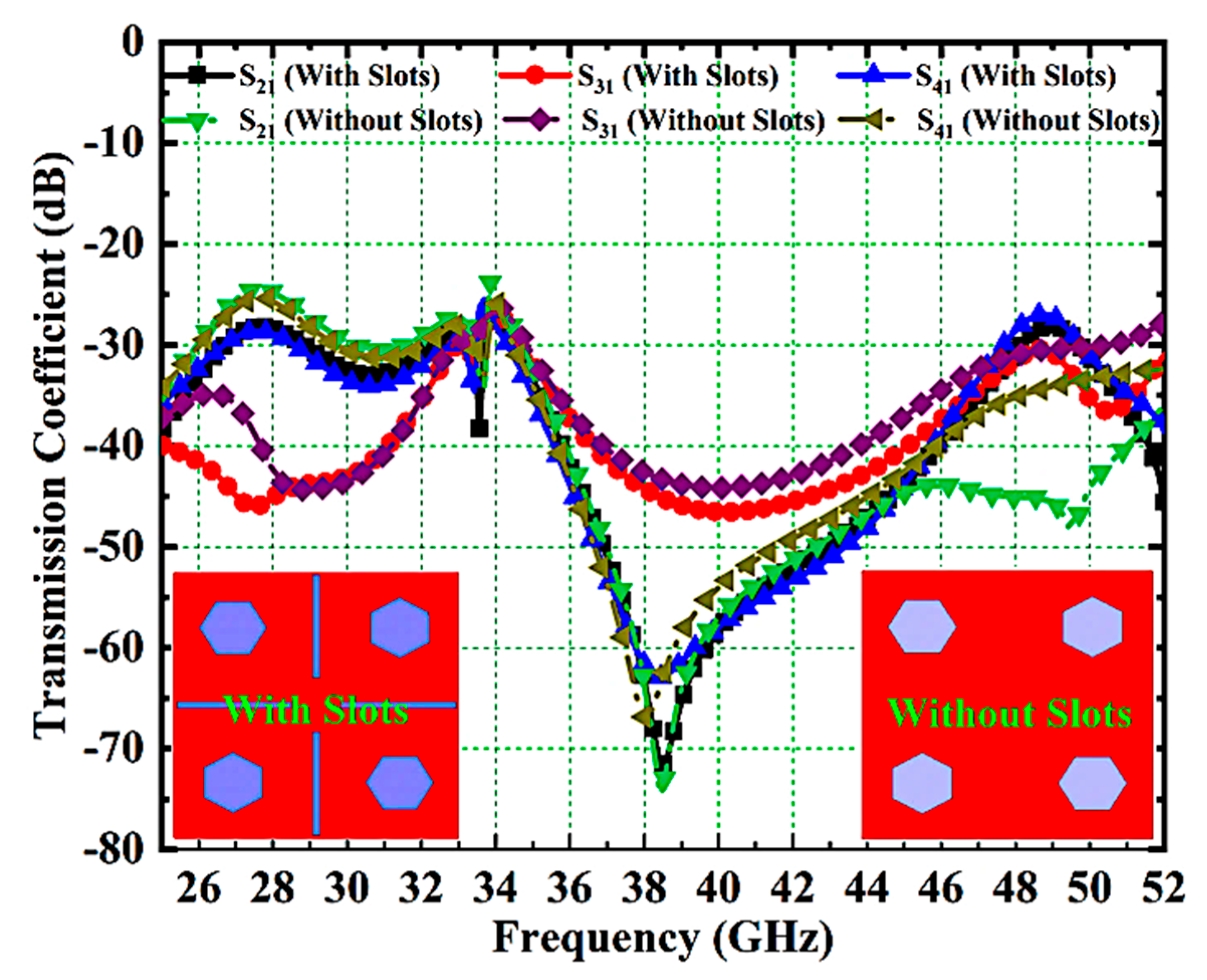
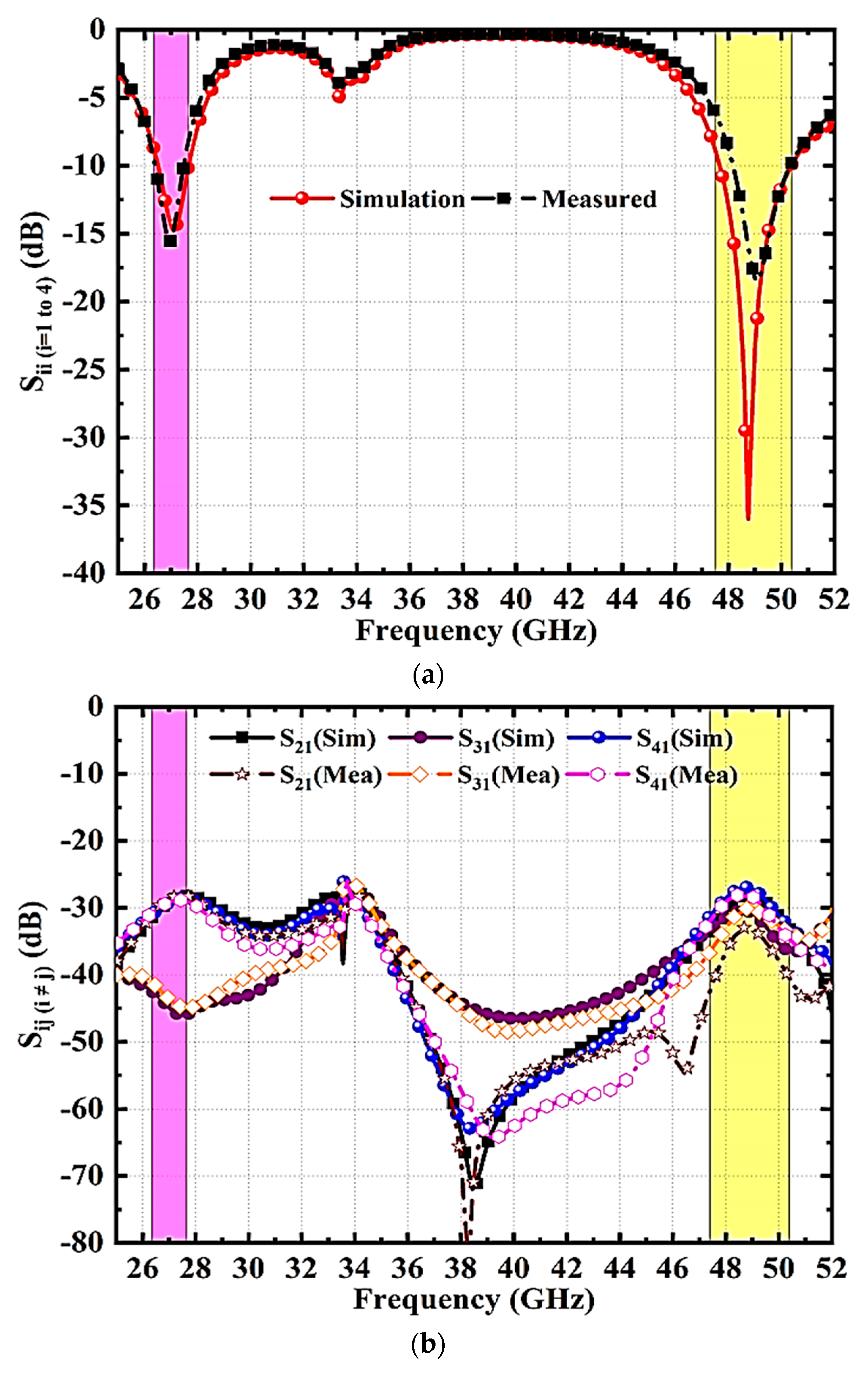
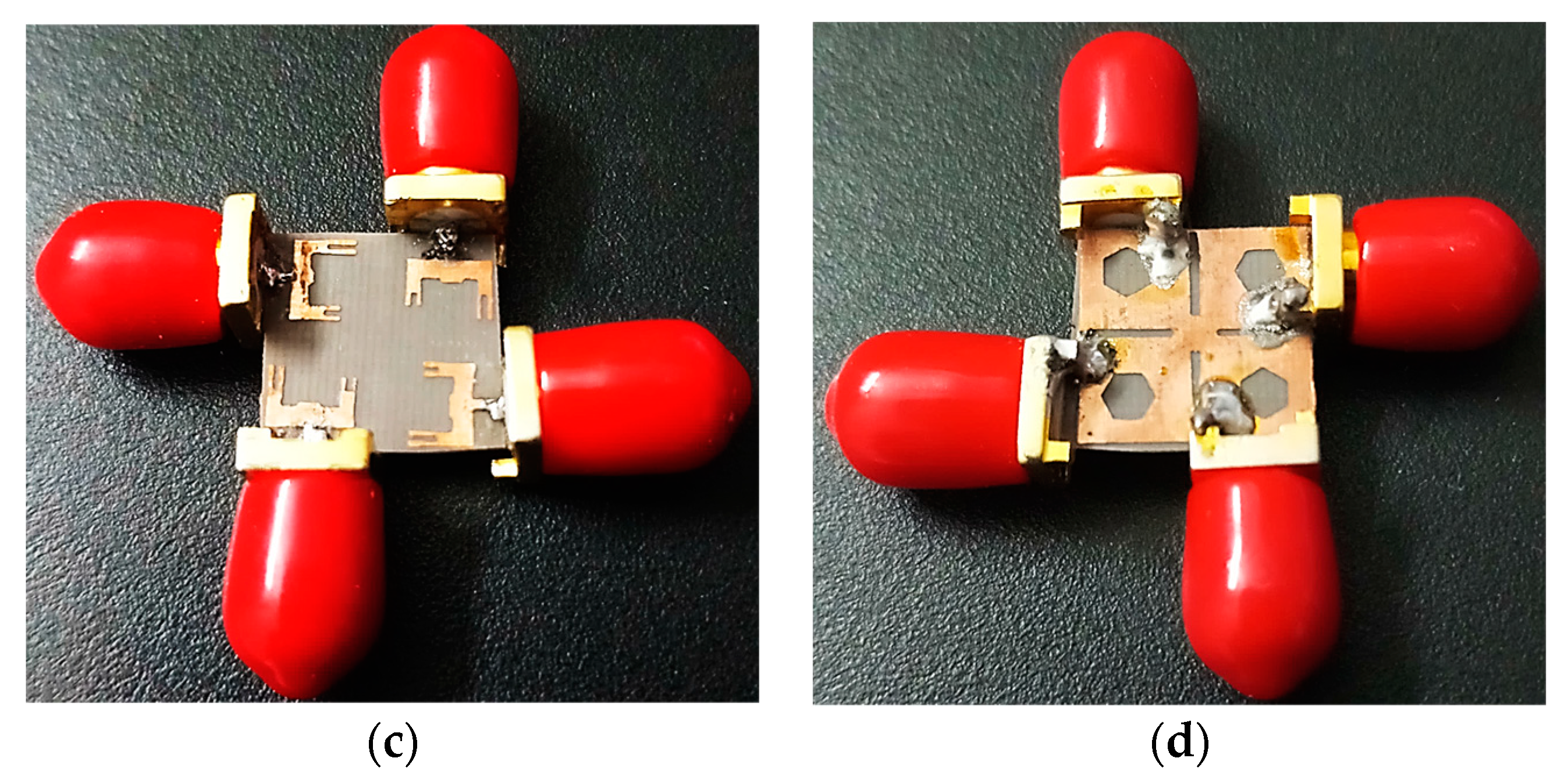
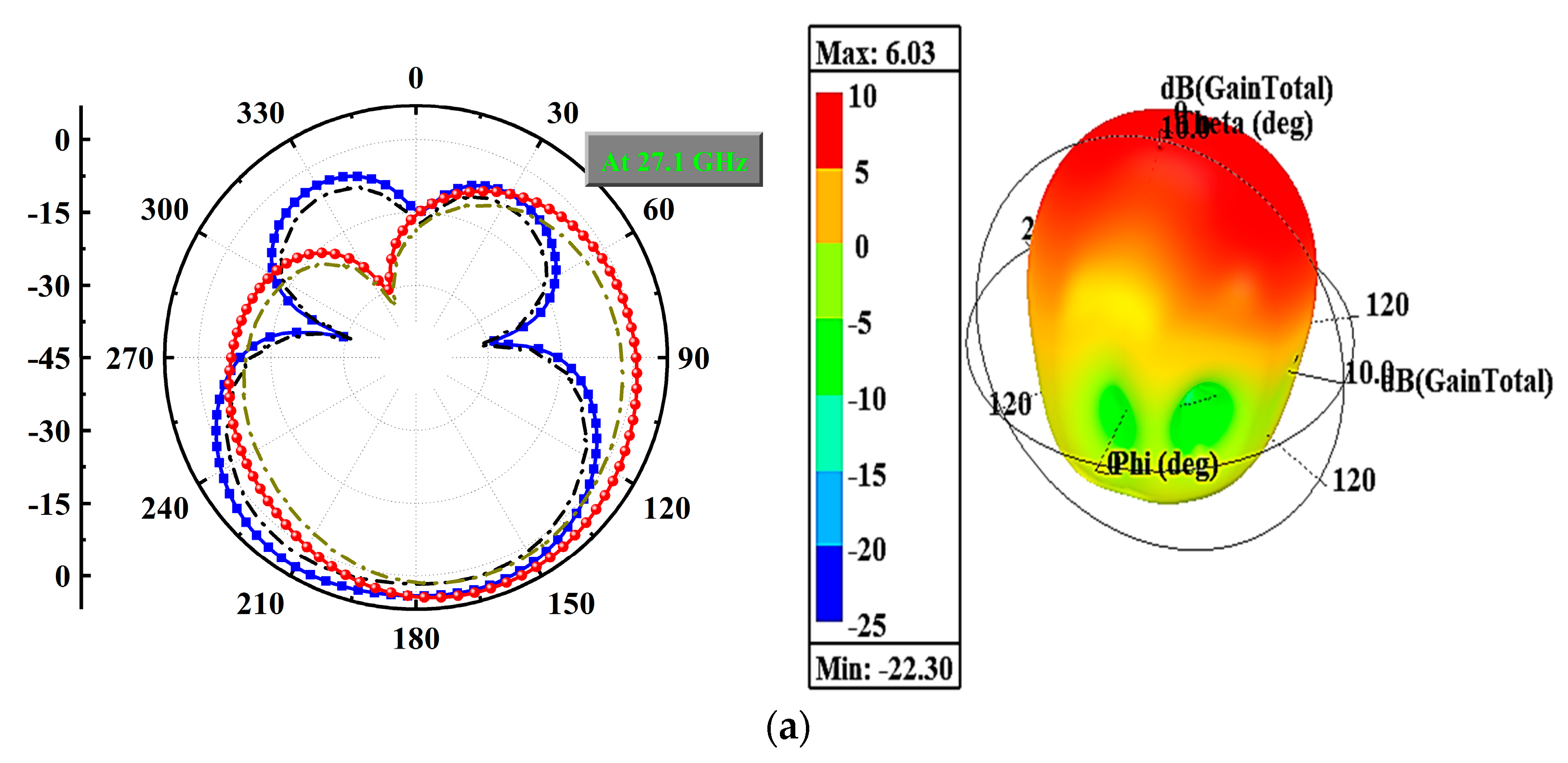
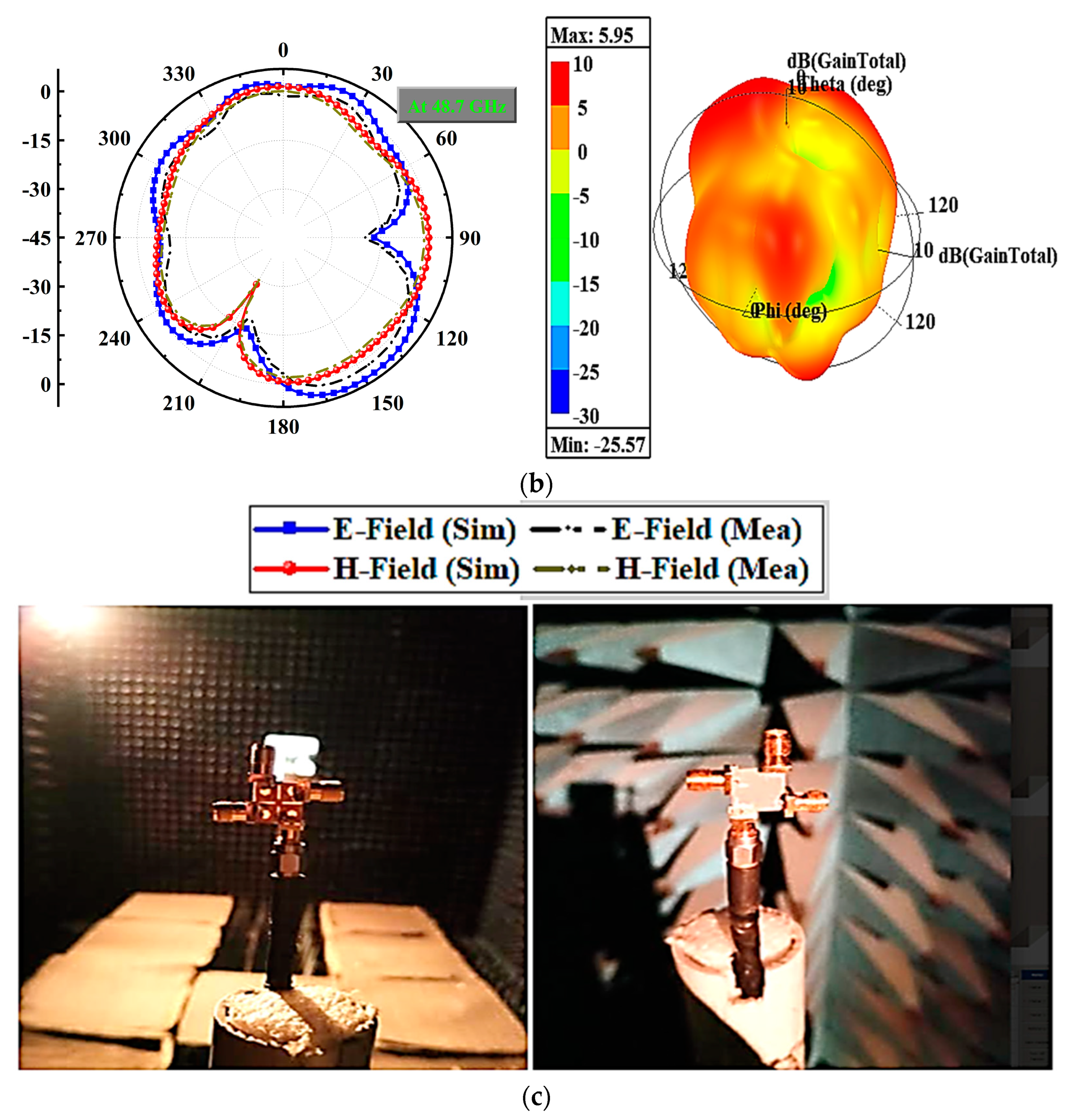

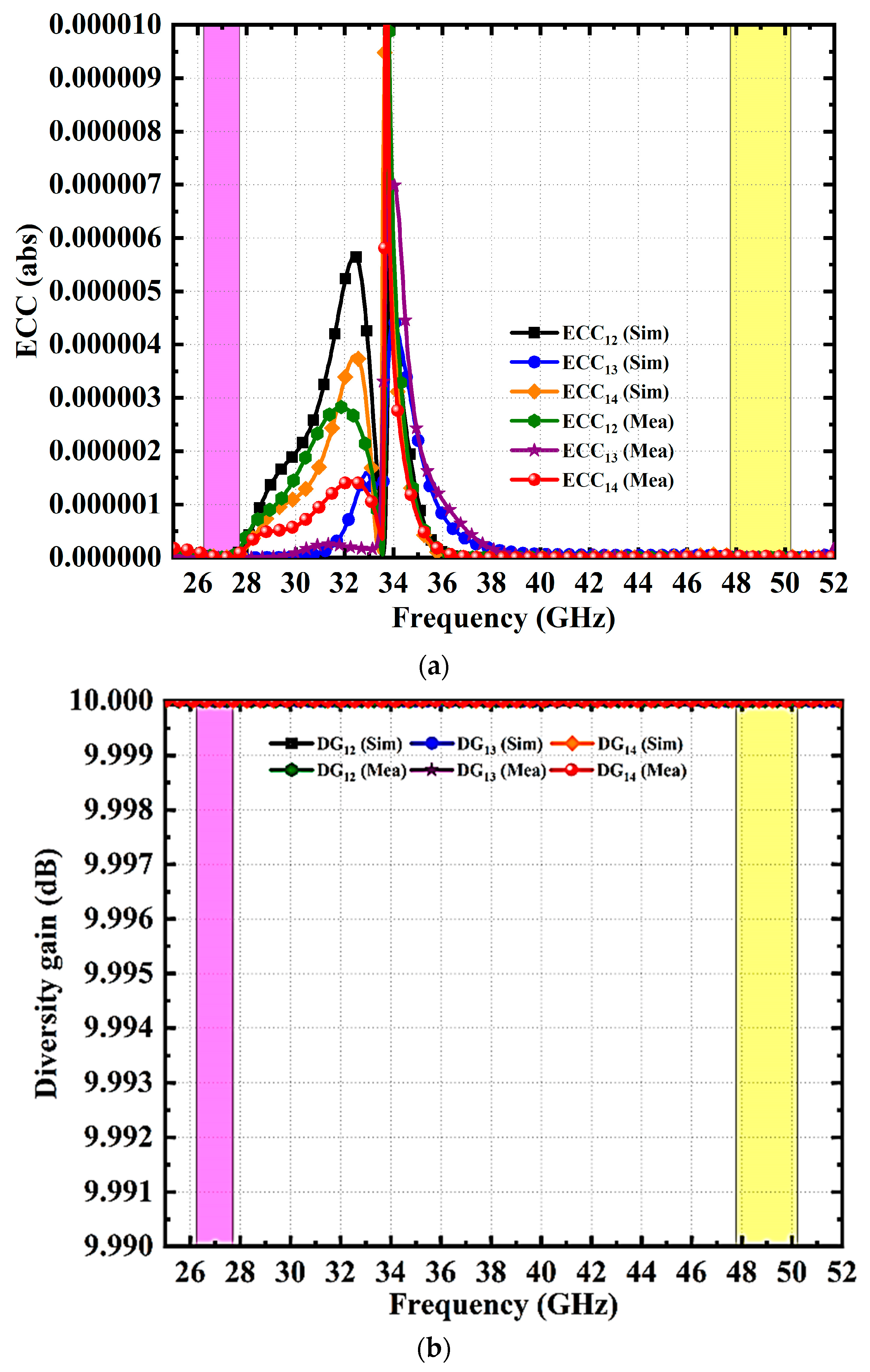
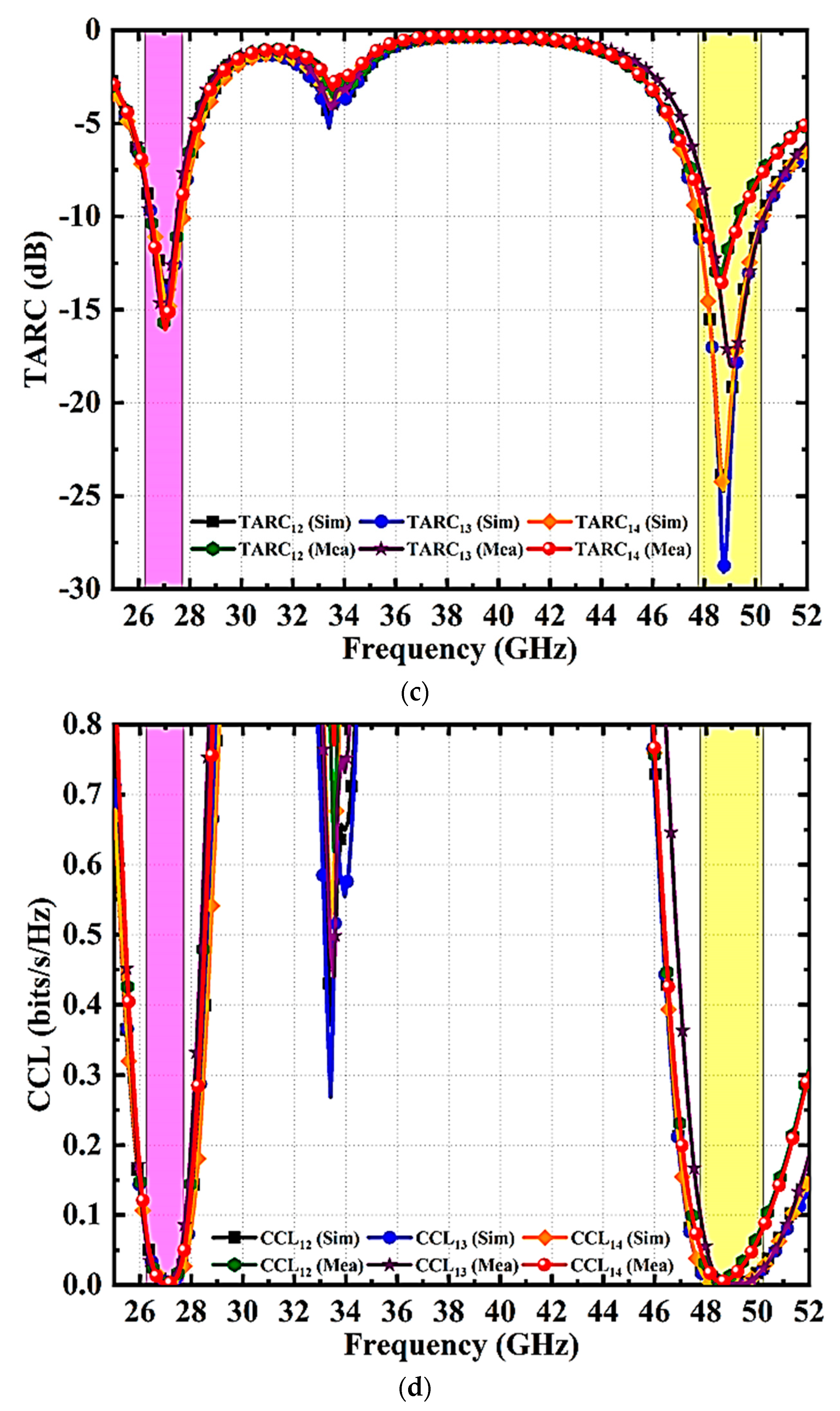

| Ref. | No., of Elements | Size (in mm3) | Bands (GHz) | Isolation (dB) | Gain (dBi) | R.E (%) | ECC | DG (dB) | TARC (dB) | CCL (bits/s/Hz) | MEG (dB) |
|---|---|---|---|---|---|---|---|---|---|---|---|
| [10] | 2 | 30 × 15 × 0.25 | 28 | >35.8 | 5.42 | - | <0.005 | 9.99 | - | <0.1 | <−3 |
| [11] | 2 | 26 × 11 × 0.8 | 28, 39 | >25 | >5 | >90 | <10−4 | - | - | - | - |
| [12] | 2 | 32 × 32 × 1.59 | 2.475, 3.47 | >15 | 5.9 | 81 | <0.02 | - | - | - | - |
| [13] | 2 | 22 × 26 × 0.8 | 3.1–11.8 | >20 | 3–6.6 | >85 | <0.03 | - | - | - | - |
| [14] | 2 | 18 × 21 × 0.8 | 2.8–12.2 | >25 | 2–5 | - | <0.013 | - | - | - | - |
| [15] | 2 | 27.65 × 12 × 0.203 | 28, 38 | >22 | >5.2 | >91 | <10−5 | 9.99 | <−10 | <0.4 | - |
| [17] | 2 | 60 × 100 × 0.813 | 28 | >18 | >5 | >85 | <0.0005 | 9.99 | - | 0.15 | - |
| [18] | 2 | 30 × 15 × 0.203 | 28, 38 | >32 | 5.7 | - | <10−4 | 10 | - | <0.3 | - |
| [19] | 2 | 7.5 × 8.8 × 0.25 | 28, 38 | >20 | >5.3 | - | <0.01 | 9.98 | - | - | - |
| [20] | 2 | 15.3 × 8.5 × 0.79 | 28, 38 | >25 | - | >83 | - | - | - | - | - |
| [21] | 4 | 158 × 77.8 × 0.381 | 28, 37, 38 | >17 | 7.2 | >70 | - | - | - | - | - |
| [22] | 4 | 104 × 104 × 0.51 | 2.45, 2.6, 5.2, 24, 28 | >16 | >6 | >85 | - | - | - | - | - |
| [23] | 4 | 19.25 × 26 × 0.79 | 28, 38 | >25 | >5.72 | >86 | <0.004 | - | - | - | - |
| [24] | 4 | 50 × 12 × 0.8 | 25.1–37.5 | >22 | >6 | >80 | <0.001 | - | - | - | - |
| [26] | 4 | 30 × 35 × 0.76 | 25.5–29.6 | >17 | >6 | >80 | <0.01 | 9.96 | - | <0.4 | <−6 |
| [27] | 4 | 30 × 35 × 0.787 | 28 | >40 | >8 | >80 | <0.0003 | 9.96 | - | <0.4 | <−5 |
| [28] | 4 | 30 × 30 × 1.575 | 28 | >30 | >6 | >90 | <0.0005 | 9.99 | - | <0.15 | <−6 |
| [29] | 4 | 28 × 28 × 0.79 | 28, 38 | >25 | >4 | - | <0.001 | 9.98 | - | <0.5 | <−5.5 |
| [30] | 4 | 20 × 20 × 0.79 | 28, 38 | >24 | >6 | >83 | <0.0001 | 9.99 | - | <0.4 | - |
| Pro. | 4 | 12 × 11.6 × 0.508 | 27.1, 48.7 | >27 | >6 | >90 | <10−6 | 9.99 | <−10 | <0.03 | <−3 |
Disclaimer/Publisher’s Note: The statements, opinions and data contained in all publications are solely those of the individual author(s) and contributor(s) and not of MDPI and/or the editor(s). MDPI and/or the editor(s) disclaim responsibility for any injury to people or property resulting from any ideas, methods, instructions or products referred to in the content. |
© 2023 by the authors. Licensee MDPI, Basel, Switzerland. This article is an open access article distributed under the terms and conditions of the Creative Commons Attribution (CC BY) license (https://creativecommons.org/licenses/by/4.0/).
Share and Cite
Jetti, C.R.; Addepalli, T.; Devireddy, S.R.; Tanimki, G.K.; Al-Gburi, A.J.A.; Zakaria, Z.; Sunitha, P. Design and Analysis of Modified U-Shaped Four Element MIMO Antenna for Dual-Band 5G Millimeter Wave Applications. Micromachines 2023, 14, 1545. https://doi.org/10.3390/mi14081545
Jetti CR, Addepalli T, Devireddy SR, Tanimki GK, Al-Gburi AJA, Zakaria Z, Sunitha P. Design and Analysis of Modified U-Shaped Four Element MIMO Antenna for Dual-Band 5G Millimeter Wave Applications. Micromachines. 2023; 14(8):1545. https://doi.org/10.3390/mi14081545
Chicago/Turabian StyleJetti, Chandrasekhar Rao, Tathababu Addepalli, Sreenivasa Rao Devireddy, Gayatri Konni Tanimki, Ahmed Jamal Abdullah Al-Gburi, Zahriladha Zakaria, and Pamarthi Sunitha. 2023. "Design and Analysis of Modified U-Shaped Four Element MIMO Antenna for Dual-Band 5G Millimeter Wave Applications" Micromachines 14, no. 8: 1545. https://doi.org/10.3390/mi14081545
APA StyleJetti, C. R., Addepalli, T., Devireddy, S. R., Tanimki, G. K., Al-Gburi, A. J. A., Zakaria, Z., & Sunitha, P. (2023). Design and Analysis of Modified U-Shaped Four Element MIMO Antenna for Dual-Band 5G Millimeter Wave Applications. Micromachines, 14(8), 1545. https://doi.org/10.3390/mi14081545







